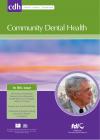Community Dental Health

- Cover Date:
- December 2009
- Print ISSN:
- 0265 539X
- Vol:
- 26
- Issue:
- 4
The periodontal health of Nepalese schoolchildren
Objectives: To report on the periodontal status of schoolchildren in urban and rural Nepal and to identify possible risk indicators of poor periodontal health. Design: Cross-sectional ‘pathfinder’ survey using the stratified cluster sampling technique included seven urban and nine rural sites representing the three geographic divisions and five political regions of Nepal. Second stage sampling involved the random selection of 25 schools (18 government and seven private). Subjects: Final study population consisted of three age groups: 5-6-years (n = 1025), 12-13-years (n = 1037) and 15-16-years (n = 1053). Outcome measures: Periodontal data was collected using CPI based on WHO methodology and criteria by trained examiners. A structured questionnaire was administered to collect information on oral health behavior and socio-economic status. Results: A gradual decline in the mean number of healthy sextants was noted with an increase in age among the schoolchildren. Males and females within a specific school and area showed no statistical significant difference when assessed for differences in score 0 (healthy periodontium) among all age groups except for 15-16-year-olds studying in government-urban schools. Multivariate logistic regression analyses showed that children 5 to 6 years of age studying in government urban (Adjusted Odds Ratio = 1.5, 95% Confidence Interval = 1.1-2.1) and government rural schools (Adj OR = 2.8, 95% CI 1.9-4.1) were at higher risk of having periodontal conditions (CPI scores > 0) when compared to those in private urban schools. The probability of poorer periodontal status increased for 12 to 13 (Adjusted OR = 1.9, 95% CI 1.3-2.9) and 15 to 16-year-old children (Adjusted OR = 1.7, 95% CI 1.1-2.5) who studied in government rural schools. Conclusions: A steady increase in periodontal conditions was observed with increasing age. The main risk indicator for unhealthy periodontal status at 5-6 years was studying and residing in government rural and urban schools; while the indicator of unhealthy periodontal status for children 12 to 13 and 15 to 16 years of age was studying in rural government schools.
Key words: CPI, Nepal, periodontal health.
- Article Price
- £15.00
- Institution Article Price
- £
- Page Start
- 250
- Page End
- 256
- Authors
- R. Yee, J. David, D. Lama
Articles from this issue
- Title
- Pg. Start
- Pg. End
- Evaluation of the direct and diffusion methods for the determination of fluoride content in table salt
- 204
- 210
- Rural Mexican immigrant parents’ interpretation of children’s dental symptoms and decisions to seek treatment
- 216
- 221
- Assessment of HIV/AIDS awareness among 500 patients referred to the Ankara University Faculty of Dentistry
- 222
- 226
- Professional charges not reimbursed to dentists in the US: evidence from Medical Expenditure Panel Survey, 1996.
- 227
- 233
- Quality of life in patients with dental conditions: comparing patients’ and providers’ evaluation
- 234
- 238
